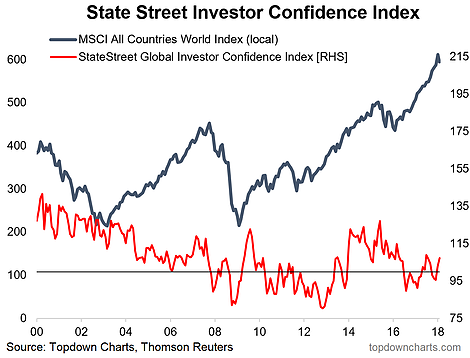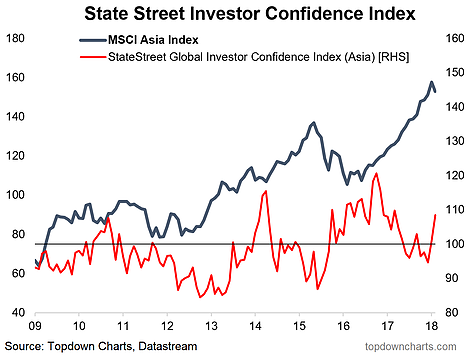The latest round of data from the State Street Investor Confidence Index [SSICI] appeared to show global institutional investors "buying the dip" following the February correction. The SSICI utilizes data from State Street's global custodian business, which administers $33 trillion in assets. The index provides a quantitative, actual, view on what institutional investors are doing (readings below 100 = reducing exposure to risky assets, readings above 100 = net-increasing).
Coincidentally our view had been to rebalance/increase exposure into the correction as it resulted in a minor shakeout of investor sentiment, slight reset in leverage, and slightly less expensive valuations. This is against a backdrop of a solid global economy and improving corporate earnings across the globe. While I would acknowledge we are "late cycle" there is yet to be any compelling evidence that the cycle is turning, so while we are at the riskier stage of the market cycle, it's not over yet.
To summarize the conclusions from institutional investor trends:
- Global institutional investors resumed allocating to stocks in February after a period of reducing allocations from Oct-Dec last year.
- Asian institutional investors were the most aggressive in raising exposure to risky assets.
- This lines up with our view that the correction was largely sentiment/technicals driven against a backdrop of improving fundamentals.
1. Global Institutional Investor Confidence: The global index shows after net-reducing exposure to risky assets from Oct-Dec institutional investors stepped up allocations in February. The market action in late Jan/early Feb did provide some reset in valuations and sentiment, and this is against a backdrop of improving earnings and a solid global macroeconomic backdrop. So even though we may be late in the business/market cycle, that large investors are "buying the dip" certainly makes some sense.

2. Asian Institutional Investor Confidence: Interestingly it was Asian institutional investors that were most aggressive in raising exposure to risky assets in February. Looking at the chart of the StateStreet Investor Confidence Index for Asia against the MSCI Asia it seems quite often when large Asian investors increase allocation to equities that Asian equities tend to follow through with a period of stronger performance. Although they were a little early in 2015 as the Chinese stock market bubble burst.

